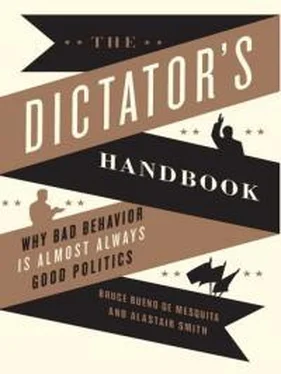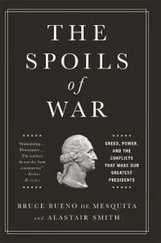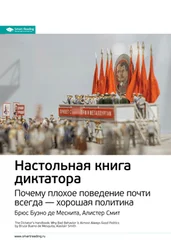Nongovernmental organizations (NGOs) have proven that they can effectively deliver basic health care and primary education. Yet harking back to our discussion of public goods provided by small-coalition regimes, we can’t help but notice that these benefits are precisely the kinds of public policy programs that even the most autocratic leaders want to initiate. NGOs are less successful at providing advanced education. Autocratic leaders in recipient states don’t want people to be taught how to think independently enough that they could organize opposition to the government.
The successes of NGOs in promoting basic education, basic health care and sanitation, and other basic necessities—digging wells, electrifying villages, making very small business loans (at what we would describe in the United States as usurious interest rates)—all point to a fundamental failing of aid programs and to the harm being done unwittingly by many NGOs and their supporters. It is a simple fact that aid money is fungible. This means recipient governments have nearly complete discretion about moving funds from one project to another. With direct government-to-government transfers it is easy to see why this is so. Autocrats want to provide private rewards for their supporters. NGOs don’t typically want to help the rich get richer and so they provide funding for specific projects or do the work themselves. However, in practice, recipients are very skilled at converting aid into the kinds of rewards they want rather than the kind of rewards donors want them to provide.
The most sensible criterion for assessing aid’s effectiveness asks not how much money is spent or even how many wells are dug, schools built, or villages electrified, but rather how many people are helped. NGOs count how much money they spend to evaluate their efficacy, but this is a flawed criterion. It encourages charities to help the easiest to reach and the more visible cases while ignoring the difficult and harder to reach people who might well be those in greatest need. Counting the number of people helped also encourages agencies to undertake work that the government would have otherwise done on its own. Remember that NGOs are most successful at providing basic public goods like primary education and basic health care—services even autocrats want. When aid funds are used to substitute for government spending, then few, maybe even no one, has actually been helped unless the government uses the freed-up money for other projects of benefit to the general population. Of course, they don’t. They use the money to shore up their political position and the loyalty of their essential backers.
Cambodia is a case in point. Half of the Cambodian government’s budget is made up of foreign aid. Rather than supplementing government programs, these donor funds are largely directed toward the bank accounts of government officials. Indeed, Cambodia ranks among the world’s most corrupt nations. As USAID reports, “Donor funds have flowed into education and health, and some of these are passed on to ordinary citizens. But, there can be little doubt a significant portion of funds earmarked for schools, teachers and textbooks, and for clinics, health workers, and medications are diverted.”20
That is, the funds intended for the people are diverted to rewards for Cambodia’s rich. Often when NGOs provide aid, the amount of assistance is substantially less than the numbers reflect. Suppose an NGO provides basic education to 100 children in a village at a cost of $100 per child per year, for a total expenditure of $10,000. It sounds like 100 people are helped by the NGO, pleasing their donors and bringing in more money. The reality of how many are helped, however, is less clear. The government might well have paid to educate half of those children (or even all of them) itself, even if there were no expectation of aid. Nominally the agency helps 100 children. But in reality they help fifty children at twice the nominal cost and let the leaders abscond with $5,000. Is this good? Well, yes, for the fifty extra children. Is it bad? Well, yes, for all of the people since the NGO is facilitating the government’s opportunity to steal more money and the NGO is helping to further entrench a bad government in power to plague the people for many more years to come.
Even some of the simplest acts of charity have bad consequences that enhance government control and irresponsibility. To take a personal example, Alastair took his children on a tour of Kenya in 2009. One of the stops was at a primary school where they were encouraged to help paint classrooms. It seems like a nice idea to help out and many people enthusiastically grabbed paintbrushes, eager to brighten the classroom. Alastair objected on principle and went outside and taught some of the kids how to use a digital camera. Was he being a Grinch or was he encouraging better economic policy? From the economic perspective, having highly skilled tourists and their families paint classrooms is at best ineffective and at worst downright harmful.
Comparative advantage lies at the heart of economics. Everyone should specialize in what they are relatively good at and then trade their goods and services. This way everyone ends up with more than if everyone tried to do a little of everything by themselves. Consider the comparative advantage of Kenya relative to Britain, where most of the people on Alastair’s trip were from. Education levels are low in Kenya and there are lots of unemployed manual laborers. Kenya’s comparative advantage is therefore in industries requiring lots of relatively unskilled labor. Indeed this is where it flourishes: Kenya is a huge exporter of flowers. It has a great climate for growing and lots of people to tend to the labor-intensive processes of growing, picking, and packaging flowers. The flowers are then flown to Western Europe for sale. In exchange, Europe exports goods that require human and physical capital to produce—pharmaceuticals, machinery, and computer software. Europe has a relative abundance of human and physical capital. It trades its capital-intensive products for Kenya’s labor-intensive agricultural products and both nations are better off.
So what has this to do with painting school classrooms? Well, painting classrooms, while fun, deprived a local worker of a much-needed job. If educated westerners displace locals from manual labor jobs, then where can those workers possibly compete given the current distribution of skills and capital? How can they earn enough money to make a living, and perhaps send their children to school to acquire greater skills that will make them more competitive when they grow up? Rather than helping out, the wealthy tourists who took up paintbrushes made some worker worse off. Repeat that exercise thousands of times and in thousands of different ways and you can see how feel-good charitable acts can benefit the donor vastly more than it actually benefits the needy.
On a much larger scale, the means of aiding needy countries can be dramatically improved by taking stock of comparative advantage. For instance, agriculture is highly protected from competition in Europe and North America through price supports and subsidies. Agriculture was deliberately excluded from the postwar trade settlement established by the General Agreement on Tariffs and Trade (GATT) and its controversial successor, the World Trade Organization (WTO). This is because rural areas are disproportionately represented in some countries and so farmers tend to be the essential backers of leaders in many European countries. Allowing farmers from developing nations to compete on the basis of comparative advantage would go much further toward promoting economic growth than providing poorly targeted and highly bureaucratized aid. Painting schools provides just one tiny example of how assistance, even when well meaning, undermines development. Bill Easterly’s work shows that rather than this being the exception, it is the norm.
Читать дальше












